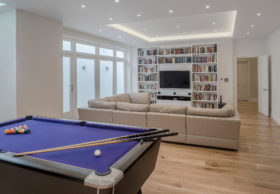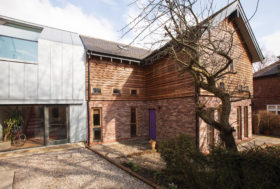

For most of us, especially if we have children, the way that we use the shared spaces in our home is far more informal than preceding generations. Older houses, designed with separate ‘boxes’ for preparing food, dining, entertaining guests and relaxing with the family are a reflection of the more formal times in which they were built.
Today, parents tend to have busy, independent working and social lives, with younger children that need supervision or older ones that are pre-occupied with their friends, homework or their computer. So, to get the family to interact more, a flexible, multi-purpose space – that allows family members to cook, watch TV or play in the garden at the same time – is needed.
Architects and builders spend a lot of time opening up kitchens and redundant dining rooms to create large, mostly open plan spaces. One of the most expensive elements in a project of this kind is installing new kitchen units, so if the scheme can be planned to incorporate the existing cabinets there will be a huge budgetary saving.
One way to refresh a worn or dated kitchen is to keep the carcasses of the cupboards and buy new doors. However, new spaces will generally be incompatible with the existing arrangement, and reconfiguring them could cause damage, meaning a new kitchen is often essential.
Aside from following the basic rules of kitchen layout design to ensure the available space is used efficiently, an important aspect of the plan is how the food preparation area relates to the rest of the new zone. Decide whether or not you want the worktop and sink areas on full view. This will allow plenty of interaction with visitors and family, but will leave unwashed pots and pans on display.
Circulation must also be considered as you’ll probably want a link between the hall, kitchen, utility room and back garden to avoid having to continually traipse through the dining and family areas.
Large open plan spaces can lack character if the surfaces are decorated the same way throughout. To create interest, wall and floor finishes can vary depending on the zone, tiles on the kitchen floor and wood in the dining area, for example.
Lighting makes a big impact, too, and can be specified according to the function. For example, the kitchen area could have bright spotlights in the ceiling and fluorescents fitted under the cupboards, whilst sitting areas would benefit from illumination at a lower level, such as standard lamps and wall lights. Another way of delineating areas is to lower the ceiling or raise the floor slightly.
A typical single storey project of this type, where the extension is added to the side or rear of a house, involves removing the wall between the dining room and kitchen. The design challenge is to ensure that the resulting space has character and does not become too gloomy. This is a particular problem with rear extensions, where the side walls are too close to the boundary for windows to let in much daylight.
Using large areas of glazing facing into the garden helps to get lighting levels up and has the benefit of showing off the garden to its best advantage. If folding sliding doors can be used, the barrier between inside and outside can be removed completely in warm weather.
Areas prone to low levels of lighting are at the rear of the existing rooms, furthest away from the garden. The most effective way to brighten up these zones is to slope the ceiling and put in rooflights. The sloping roof provides character and interest, while the rooflights flood the space with enough light to penetrate the areas at the core of the house.
The way that a rear extension is roofed over can sometimes present problems. If you want a sloping, single pitch roof with traditional plain tiles, the pitch should usually be at least 35 degrees. Unfortunately, this is so steep that by the time it meets the existing wall of the house, it will be higher than the first floor windows.
There are several alternatives to avoid this problem. If they are appropriate to the design, traditional-looking slates can be laid at relatively shallow angles. Modern concrete interlocking tiles are not particularly attractive but, provided that special fixings can be used, they can be laid at a very shallow angle. Although relatively expensive, metal roof coverings such as zinc can be laid almost flat and will give a contemporary look to the extension.
For a traditional style house, a flat roof is probably the least attractive option. The low cost may make a project viable for anyone on a tight budget, but if it is in a prominent location the planners may not be prepared to approve it. One way of making a flat roof more acceptable is to turn it into a balcony for the first floor. Provided that it is not close to a boundary and/or the sides are screened, you will be able to overcome the objections of neighbours who may be concerned that their gardens will be overlooked.
It is possible to avoid the requirement to make a planning application. The rules that allow extensions up to a certain size, called ‘permitted development rights’, work on the basis that if an extension has little impact on the neighbours or the surroundings, it is pointless to go through the planning application process.
If you think that your proposals are controversial, or you need to start building work quickly and avoid the eight-week wait for permission to come through, you may choose to adjust the design so that it complies with the permitted development rules.
On the practical side, because the extension is only on the ground floor, there should not be too many problems. To get the perfect layout, it’s often necessary to remove a long section of the existing external wall, requiring the installation of a steel support beam. If the span is great, for example, over seven or eight metres and especially if it has any other beams resting onto it, the beam will be quite deep. This can be overcome by partially embedding it in the floor above.
The installation of such a beam can be a challenge for the builder and it may be necessary to design it in two sections to be bolted together on site, just so that it can be physically carried into position.
Another common issue with extensions is the location of drain runs. Although building over them is fairly straightforward, older houses have continuous runs of drains behind them to serve a whole row of homes. Building Regulations pay more attention to these drains than to those serving one house, as it is harder to accommodate manholes and changes to the location and direction of the pipes with a shared system.
If possible, leaving existing rooms trapped in the centre of the house with no windows to the outside should be avoided. Apart from it being claustrophobic, there are regulations requiring all spaces without windows to the outside to have mechanical ventilation – which can be extremely expensive.
Main image: High-gloss kitchen by Woodstock Furniture featuring an ergonomic design for better flow between zones


Comments are closed.